godfather
New member
As you may have read I have an airhead...finally, a 72 R60/5 with 55,000 miles.

I am trying to get it running and have some very "NOOBIE" questions. Please bear with my ignorance....I am sure this is the first in a series of many questions.
I got it semi running tonight. It will only run for 20-40 secods then starts popping and an occasional backfire through carbs or exhaust then dies out. It will start back up after a slight increase in throttle. I can hold it at around 2000 rpm then it pops a bunch or backfires then dies. While it is running it does not misfire so I think timing is ok.
Can I remove intake tubes and spray carb cleaner in the carbs, or it that bad? I did remove the air cleaner because it is really dirty, and that seemed to help get it running. It does seem to run a bit longer each time I restart it so that leads me to believe it is carburation. Any idea what carbs I have? There are no plates with Bing numbers, no choke/enrichers and only one cable comming out of the top. They have primers though. Bing's website drawing shows a similar one with two cables comming out of the top type 53, I believe. Is a carb rebuild in my future? Is it difficult? Does their DVD show everything that I (someont that has never been inside a carb) would need to be successful at a rebuild? I am somewhat mechanical.
I have new plug wires and filters comming from Bob's. The plugs are new and the PO said gas is fresh.
The PO said he put it away with the tank and carbs drained...he also said it was "Mint" so take that for what it is worth. (The bike is VERY NICE, just not "mint")
Your help will be greatly appreciated.

I am trying to get it running and have some very "NOOBIE" questions. Please bear with my ignorance....I am sure this is the first in a series of many questions.
I got it semi running tonight. It will only run for 20-40 secods then starts popping and an occasional backfire through carbs or exhaust then dies out. It will start back up after a slight increase in throttle. I can hold it at around 2000 rpm then it pops a bunch or backfires then dies. While it is running it does not misfire so I think timing is ok.
Can I remove intake tubes and spray carb cleaner in the carbs, or it that bad? I did remove the air cleaner because it is really dirty, and that seemed to help get it running. It does seem to run a bit longer each time I restart it so that leads me to believe it is carburation. Any idea what carbs I have? There are no plates with Bing numbers, no choke/enrichers and only one cable comming out of the top. They have primers though. Bing's website drawing shows a similar one with two cables comming out of the top type 53, I believe. Is a carb rebuild in my future? Is it difficult? Does their DVD show everything that I (someont that has never been inside a carb) would need to be successful at a rebuild? I am somewhat mechanical.
I have new plug wires and filters comming from Bob's. The plugs are new and the PO said gas is fresh.
The PO said he put it away with the tank and carbs drained...he also said it was "Mint" so take that for what it is worth. (The bike is VERY NICE, just not "mint")
Your help will be greatly appreciated.

